Values, Ethics, and Collaborative Working Portfolio - Arden University
VerifiedAdded on 2023/06/12
|11
|3721
|208
Portfolio
AI Summary
This portfolio delves into the concepts of values, ethics, and collaborative working within a business context, using Marks and Spencer as a case study. It addresses the importance of business ethics in controlling malpractices, fostering employee relations, improving customer satisfaction, and enhancing business goodwill. The portfolio also examines corporate social responsibility (CSR) initiatives undertaken by Marks and Spencer, such as supporting food banks, community programs, fundraising, and donating equipment and clothing. Furthermore, it discusses ethical guidelines for a soft drink company, including managing plastic waste and minimizing health risks associated with sugar consumption, alongside relevant marketing, advertising, food and health regulations, and data protection legislation. Finally, the work explores the benefits of team collaboration, policies guiding collaborative work, strategies for motivating diverse teams, and the consequences of poor collaboration.
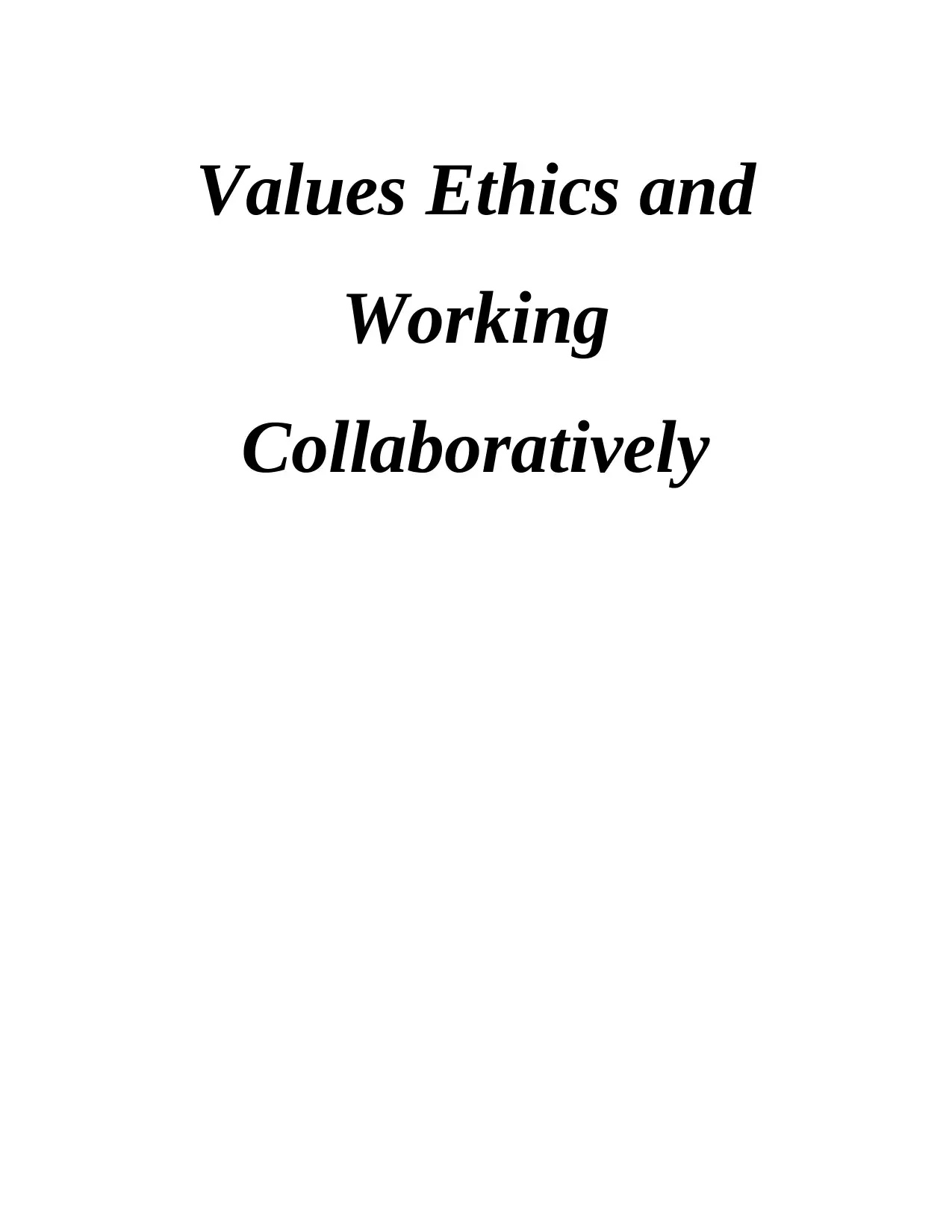
Values Ethics and
Working
Collaboratively
Working
Collaboratively
Paraphrase This Document
Need a fresh take? Get an instant paraphrase of this document with our AI Paraphraser
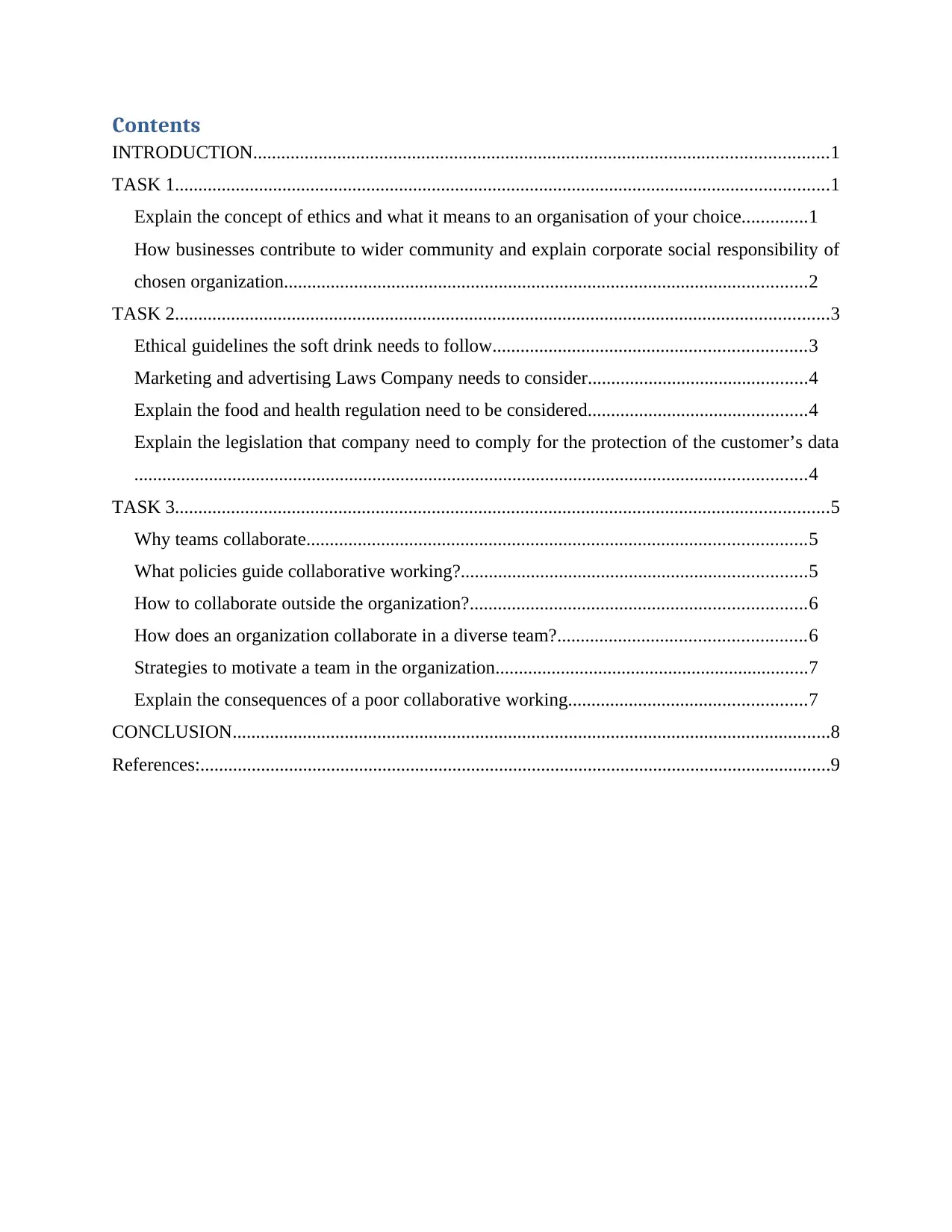
Contents
INTRODUCTION...........................................................................................................................1
TASK 1............................................................................................................................................1
Explain the concept of ethics and what it means to an organisation of your choice..............1
How businesses contribute to wider community and explain corporate social responsibility of
chosen organization................................................................................................................2
TASK 2............................................................................................................................................3
Ethical guidelines the soft drink needs to follow...................................................................3
Marketing and advertising Laws Company needs to consider...............................................4
Explain the food and health regulation need to be considered...............................................4
Explain the legislation that company need to comply for the protection of the customer’s data
................................................................................................................................................4
TASK 3............................................................................................................................................5
Why teams collaborate...........................................................................................................5
What policies guide collaborative working?..........................................................................5
How to collaborate outside the organization?........................................................................6
How does an organization collaborate in a diverse team?.....................................................6
Strategies to motivate a team in the organization...................................................................7
Explain the consequences of a poor collaborative working...................................................7
CONCLUSION................................................................................................................................8
References:.......................................................................................................................................9
INTRODUCTION...........................................................................................................................1
TASK 1............................................................................................................................................1
Explain the concept of ethics and what it means to an organisation of your choice..............1
How businesses contribute to wider community and explain corporate social responsibility of
chosen organization................................................................................................................2
TASK 2............................................................................................................................................3
Ethical guidelines the soft drink needs to follow...................................................................3
Marketing and advertising Laws Company needs to consider...............................................4
Explain the food and health regulation need to be considered...............................................4
Explain the legislation that company need to comply for the protection of the customer’s data
................................................................................................................................................4
TASK 3............................................................................................................................................5
Why teams collaborate...........................................................................................................5
What policies guide collaborative working?..........................................................................5
How to collaborate outside the organization?........................................................................6
How does an organization collaborate in a diverse team?.....................................................6
Strategies to motivate a team in the organization...................................................................7
Explain the consequences of a poor collaborative working...................................................7
CONCLUSION................................................................................................................................8
References:.......................................................................................................................................9
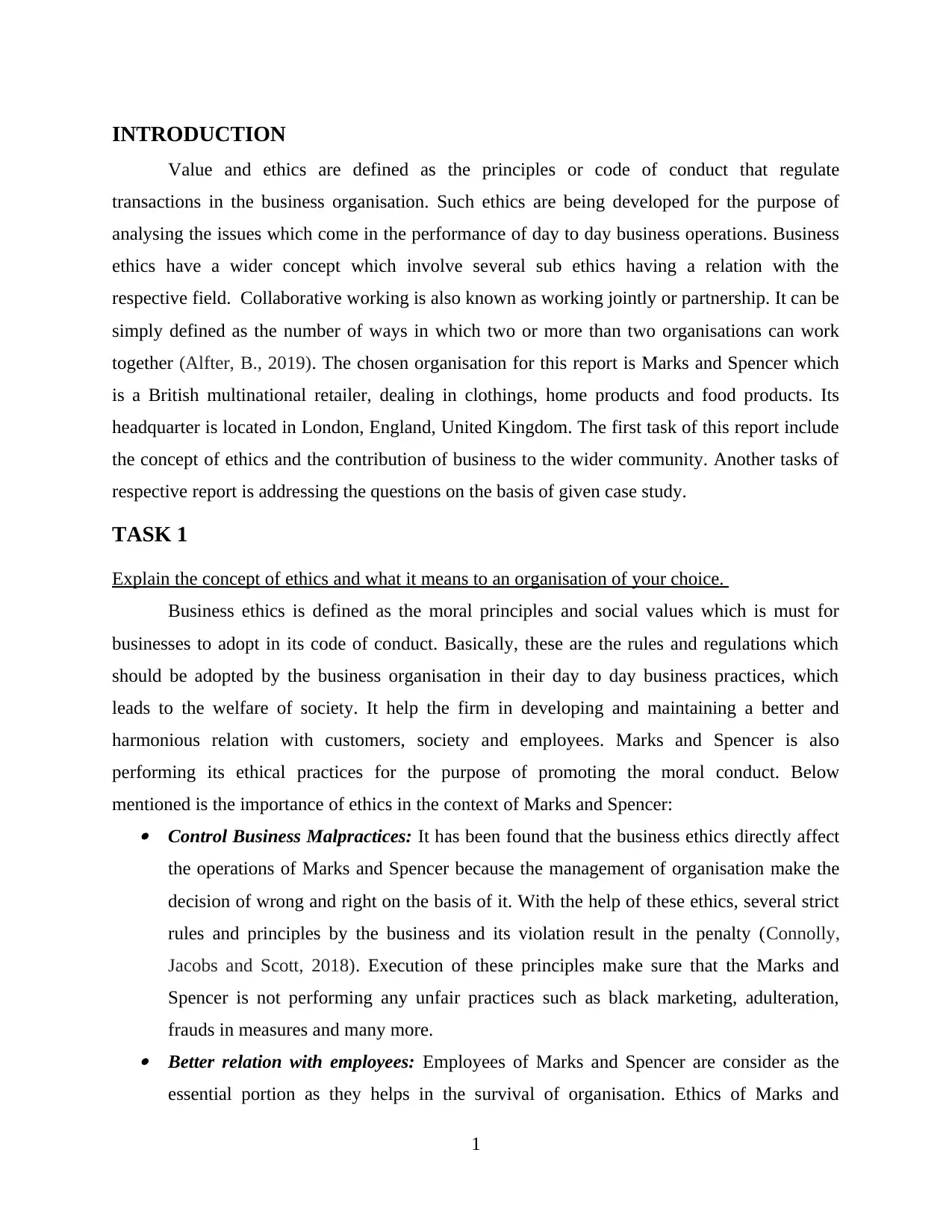
INTRODUCTION
Value and ethics are defined as the principles or code of conduct that regulate
transactions in the business organisation. Such ethics are being developed for the purpose of
analysing the issues which come in the performance of day to day business operations. Business
ethics have a wider concept which involve several sub ethics having a relation with the
respective field. Collaborative working is also known as working jointly or partnership. It can be
simply defined as the number of ways in which two or more than two organisations can work
together (Alfter, B., 2019). The chosen organisation for this report is Marks and Spencer which
is a British multinational retailer, dealing in clothings, home products and food products. Its
headquarter is located in London, England, United Kingdom. The first task of this report include
the concept of ethics and the contribution of business to the wider community. Another tasks of
respective report is addressing the questions on the basis of given case study.
TASK 1
Explain the concept of ethics and what it means to an organisation of your choice.
Business ethics is defined as the moral principles and social values which is must for
businesses to adopt in its code of conduct. Basically, these are the rules and regulations which
should be adopted by the business organisation in their day to day business practices, which
leads to the welfare of society. It help the firm in developing and maintaining a better and
harmonious relation with customers, society and employees. Marks and Spencer is also
performing its ethical practices for the purpose of promoting the moral conduct. Below
mentioned is the importance of ethics in the context of Marks and Spencer: Control Business Malpractices: It has been found that the business ethics directly affect
the operations of Marks and Spencer because the management of organisation make the
decision of wrong and right on the basis of it. With the help of these ethics, several strict
rules and principles by the business and its violation result in the penalty (Connolly,
Jacobs and Scott, 2018). Execution of these principles make sure that the Marks and
Spencer is not performing any unfair practices such as black marketing, adulteration,
frauds in measures and many more. Better relation with employees: Employees of Marks and Spencer are consider as the
essential portion as they helps in the survival of organisation. Ethics of Marks and
1
Value and ethics are defined as the principles or code of conduct that regulate
transactions in the business organisation. Such ethics are being developed for the purpose of
analysing the issues which come in the performance of day to day business operations. Business
ethics have a wider concept which involve several sub ethics having a relation with the
respective field. Collaborative working is also known as working jointly or partnership. It can be
simply defined as the number of ways in which two or more than two organisations can work
together (Alfter, B., 2019). The chosen organisation for this report is Marks and Spencer which
is a British multinational retailer, dealing in clothings, home products and food products. Its
headquarter is located in London, England, United Kingdom. The first task of this report include
the concept of ethics and the contribution of business to the wider community. Another tasks of
respective report is addressing the questions on the basis of given case study.
TASK 1
Explain the concept of ethics and what it means to an organisation of your choice.
Business ethics is defined as the moral principles and social values which is must for
businesses to adopt in its code of conduct. Basically, these are the rules and regulations which
should be adopted by the business organisation in their day to day business practices, which
leads to the welfare of society. It help the firm in developing and maintaining a better and
harmonious relation with customers, society and employees. Marks and Spencer is also
performing its ethical practices for the purpose of promoting the moral conduct. Below
mentioned is the importance of ethics in the context of Marks and Spencer: Control Business Malpractices: It has been found that the business ethics directly affect
the operations of Marks and Spencer because the management of organisation make the
decision of wrong and right on the basis of it. With the help of these ethics, several strict
rules and principles by the business and its violation result in the penalty (Connolly,
Jacobs and Scott, 2018). Execution of these principles make sure that the Marks and
Spencer is not performing any unfair practices such as black marketing, adulteration,
frauds in measures and many more. Better relation with employees: Employees of Marks and Spencer are consider as the
essential portion as they helps in the survival of organisation. Ethics of Marks and
1
⊘ This is a preview!⊘
Do you want full access?
Subscribe today to unlock all pages.

Trusted by 1+ million students worldwide
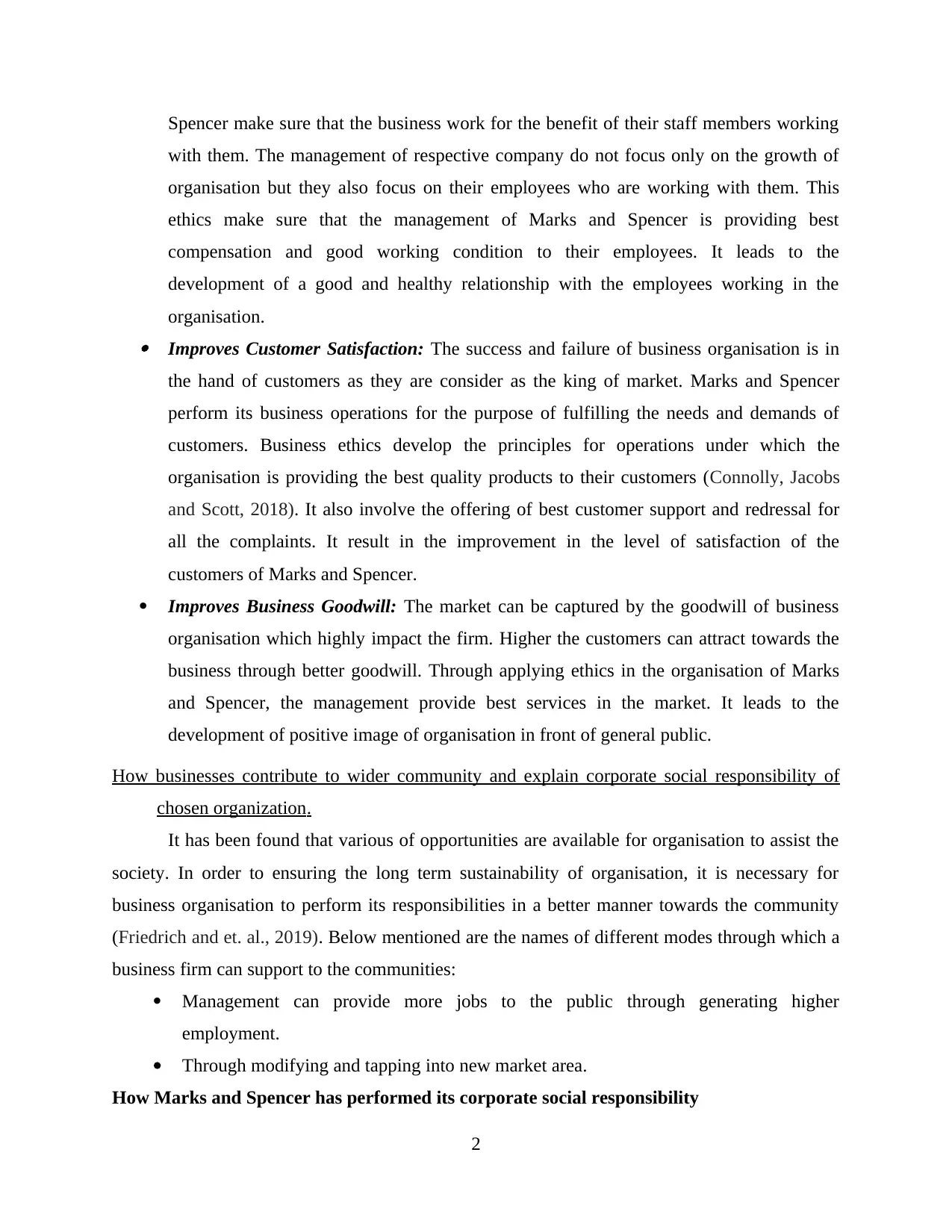
Spencer make sure that the business work for the benefit of their staff members working
with them. The management of respective company do not focus only on the growth of
organisation but they also focus on their employees who are working with them. This
ethics make sure that the management of Marks and Spencer is providing best
compensation and good working condition to their employees. It leads to the
development of a good and healthy relationship with the employees working in the
organisation. Improves Customer Satisfaction: The success and failure of business organisation is in
the hand of customers as they are consider as the king of market. Marks and Spencer
perform its business operations for the purpose of fulfilling the needs and demands of
customers. Business ethics develop the principles for operations under which the
organisation is providing the best quality products to their customers (Connolly, Jacobs
and Scott, 2018). It also involve the offering of best customer support and redressal for
all the complaints. It result in the improvement in the level of satisfaction of the
customers of Marks and Spencer.
Improves Business Goodwill: The market can be captured by the goodwill of business
organisation which highly impact the firm. Higher the customers can attract towards the
business through better goodwill. Through applying ethics in the organisation of Marks
and Spencer, the management provide best services in the market. It leads to the
development of positive image of organisation in front of general public.
How businesses contribute to wider community and explain corporate social responsibility of
chosen organization.
It has been found that various of opportunities are available for organisation to assist the
society. In order to ensuring the long term sustainability of organisation, it is necessary for
business organisation to perform its responsibilities in a better manner towards the community
(Friedrich and et. al., 2019). Below mentioned are the names of different modes through which a
business firm can support to the communities:
Management can provide more jobs to the public through generating higher
employment.
Through modifying and tapping into new market area.
How Marks and Spencer has performed its corporate social responsibility
2
with them. The management of respective company do not focus only on the growth of
organisation but they also focus on their employees who are working with them. This
ethics make sure that the management of Marks and Spencer is providing best
compensation and good working condition to their employees. It leads to the
development of a good and healthy relationship with the employees working in the
organisation. Improves Customer Satisfaction: The success and failure of business organisation is in
the hand of customers as they are consider as the king of market. Marks and Spencer
perform its business operations for the purpose of fulfilling the needs and demands of
customers. Business ethics develop the principles for operations under which the
organisation is providing the best quality products to their customers (Connolly, Jacobs
and Scott, 2018). It also involve the offering of best customer support and redressal for
all the complaints. It result in the improvement in the level of satisfaction of the
customers of Marks and Spencer.
Improves Business Goodwill: The market can be captured by the goodwill of business
organisation which highly impact the firm. Higher the customers can attract towards the
business through better goodwill. Through applying ethics in the organisation of Marks
and Spencer, the management provide best services in the market. It leads to the
development of positive image of organisation in front of general public.
How businesses contribute to wider community and explain corporate social responsibility of
chosen organization.
It has been found that various of opportunities are available for organisation to assist the
society. In order to ensuring the long term sustainability of organisation, it is necessary for
business organisation to perform its responsibilities in a better manner towards the community
(Friedrich and et. al., 2019). Below mentioned are the names of different modes through which a
business firm can support to the communities:
Management can provide more jobs to the public through generating higher
employment.
Through modifying and tapping into new market area.
How Marks and Spencer has performed its corporate social responsibility
2
Paraphrase This Document
Need a fresh take? Get an instant paraphrase of this document with our AI Paraphraser

Corporate Social Responsibilities are defined as the principles which have been
conducted by the business organisations for the purpose of contributing towards the society
(Wihlborg and et. al., 2018). The management of Marks and Spencer found that the performing
CSR helps the organisation in gaining the optimistic effect for their growth. The CSR techniques
of firm support the management in the growth and development of society. Below mentioned are
the several methods through which the management of Marks and Spencer is supporting to the
society:
Corporation with the food Banks: The management is fully aware regarding the waste
of food goods, which can be a burden on the environment and cause a social upheaval.
As a result, organisations encourage people to strive not to waste food that could be used
by others. The management is concentrating on distributing food to a number of
organisations.
Support for the community programs: Marks and Spencer focuses on contributing to a
number of charitable foundations that are run by local shops (Gölgeci and et. al., 2019).
All of the company's stores have a restricted budget and focus on assisting with issues
that are more pressing in their respective communities.
Fundraising: The management of Marks and Spencer also focus on the donating some
amount of money for any special event or programme which is beneficial for the society.
It is consider as the social work. For example, they focus on raising donations for the
Breakthrough Breast Cancer initiative.
Equipment and Clothing: The majority of the organization's surplus clothing and
corporate surplus is donated to various charitable trusts, such as NewLife, which funds
clinical research, awareness initiatives, nursing support, and crucial items for specially
abled and terminally sick children. M&S's management donates money to
underprivileged children every year from the sale and recycling of clothing.
TASK 2
Ethical guidelines the soft drink needs to follow
The soft drink company must consider a number of factors, which are briefly discussed below:
Plastic garbage floating islands: According to the survey, islands of plastic waste were
discovered in the year 2017. Bottle tops and plastic bottles are both made of the same
3
conducted by the business organisations for the purpose of contributing towards the society
(Wihlborg and et. al., 2018). The management of Marks and Spencer found that the performing
CSR helps the organisation in gaining the optimistic effect for their growth. The CSR techniques
of firm support the management in the growth and development of society. Below mentioned are
the several methods through which the management of Marks and Spencer is supporting to the
society:
Corporation with the food Banks: The management is fully aware regarding the waste
of food goods, which can be a burden on the environment and cause a social upheaval.
As a result, organisations encourage people to strive not to waste food that could be used
by others. The management is concentrating on distributing food to a number of
organisations.
Support for the community programs: Marks and Spencer focuses on contributing to a
number of charitable foundations that are run by local shops (Gölgeci and et. al., 2019).
All of the company's stores have a restricted budget and focus on assisting with issues
that are more pressing in their respective communities.
Fundraising: The management of Marks and Spencer also focus on the donating some
amount of money for any special event or programme which is beneficial for the society.
It is consider as the social work. For example, they focus on raising donations for the
Breakthrough Breast Cancer initiative.
Equipment and Clothing: The majority of the organization's surplus clothing and
corporate surplus is donated to various charitable trusts, such as NewLife, which funds
clinical research, awareness initiatives, nursing support, and crucial items for specially
abled and terminally sick children. M&S's management donates money to
underprivileged children every year from the sale and recycling of clothing.
TASK 2
Ethical guidelines the soft drink needs to follow
The soft drink company must consider a number of factors, which are briefly discussed below:
Plastic garbage floating islands: According to the survey, islands of plastic waste were
discovered in the year 2017. Bottle tops and plastic bottles are both made of the same
3

material. As a result, it is the responsibility of the soft drink industry to limit the use of
plastic to the largest extent possible in order to protect the environment from harm.
Sugar - a sticky problem: Sugar is the primary cause of people's poor health in today's
world. It improves cardiac and diabetes-related problems (Gutiérrez and Gant, 2018). As
a result, it is the responsibility of the particular company to focus on minimising the
health risks associated with soft drink use. Several ingredients that are potentially
hazardous to people's health must be avoided by the company.
Marketing and advertising Laws Company needs to consider
Consumer advertising: A slew of rules and legislation govern how businesses promote the
products to the consumers. This type of rule protects consumers since it stems from a 2008
statute that protected customers from various unfair trading regulations, which was later
amended in 2014. It prohibits an organisation from using advertisements to mislead or
harass its customers.
Business advertising: Protecting businesses against deceptive advertising legislation, which
includes the law on marketing to businesses. All advertisements must be both factual and
genuine. Apart from that, companies should avoid making any misleading comparisons with
their market competitors.
Explain the food and health regulation need to be considered
The Food and Drug Administration is responsible for ensuring that imported and domestic foods
are safe, nutritious, sanitary, healthy, and properly labelled. The cosmetic act, drug act, federal
food act, and public health service act are the key statutes that govern FDA's operations
(Holbeche, 2018). The health and food act was enacted to improve laws relating to health and to
position safety in order to establish base criteria for food items, regulate their warehousing,
supply, and ensure that food is available in a manner that is safe for people's health.
Explain the legislation that company need to comply for the protection of the customer’s data
In order to protect the personal information of customers, the company is required to follow
the Information Protection Act of 1998. This law gives the firm the right to access the
organization's data. This law is the most important piece of legislation governing the protection
of personal information in the United Kingdom. This information protection law aids people in
4
plastic to the largest extent possible in order to protect the environment from harm.
Sugar - a sticky problem: Sugar is the primary cause of people's poor health in today's
world. It improves cardiac and diabetes-related problems (Gutiérrez and Gant, 2018). As
a result, it is the responsibility of the particular company to focus on minimising the
health risks associated with soft drink use. Several ingredients that are potentially
hazardous to people's health must be avoided by the company.
Marketing and advertising Laws Company needs to consider
Consumer advertising: A slew of rules and legislation govern how businesses promote the
products to the consumers. This type of rule protects consumers since it stems from a 2008
statute that protected customers from various unfair trading regulations, which was later
amended in 2014. It prohibits an organisation from using advertisements to mislead or
harass its customers.
Business advertising: Protecting businesses against deceptive advertising legislation, which
includes the law on marketing to businesses. All advertisements must be both factual and
genuine. Apart from that, companies should avoid making any misleading comparisons with
their market competitors.
Explain the food and health regulation need to be considered
The Food and Drug Administration is responsible for ensuring that imported and domestic foods
are safe, nutritious, sanitary, healthy, and properly labelled. The cosmetic act, drug act, federal
food act, and public health service act are the key statutes that govern FDA's operations
(Holbeche, 2018). The health and food act was enacted to improve laws relating to health and to
position safety in order to establish base criteria for food items, regulate their warehousing,
supply, and ensure that food is available in a manner that is safe for people's health.
Explain the legislation that company need to comply for the protection of the customer’s data
In order to protect the personal information of customers, the company is required to follow
the Information Protection Act of 1998. This law gives the firm the right to access the
organization's data. This law is the most important piece of legislation governing the protection
of personal information in the United Kingdom. This information protection law aids people in
4
⊘ This is a preview!⊘
Do you want full access?
Subscribe today to unlock all pages.

Trusted by 1+ million students worldwide
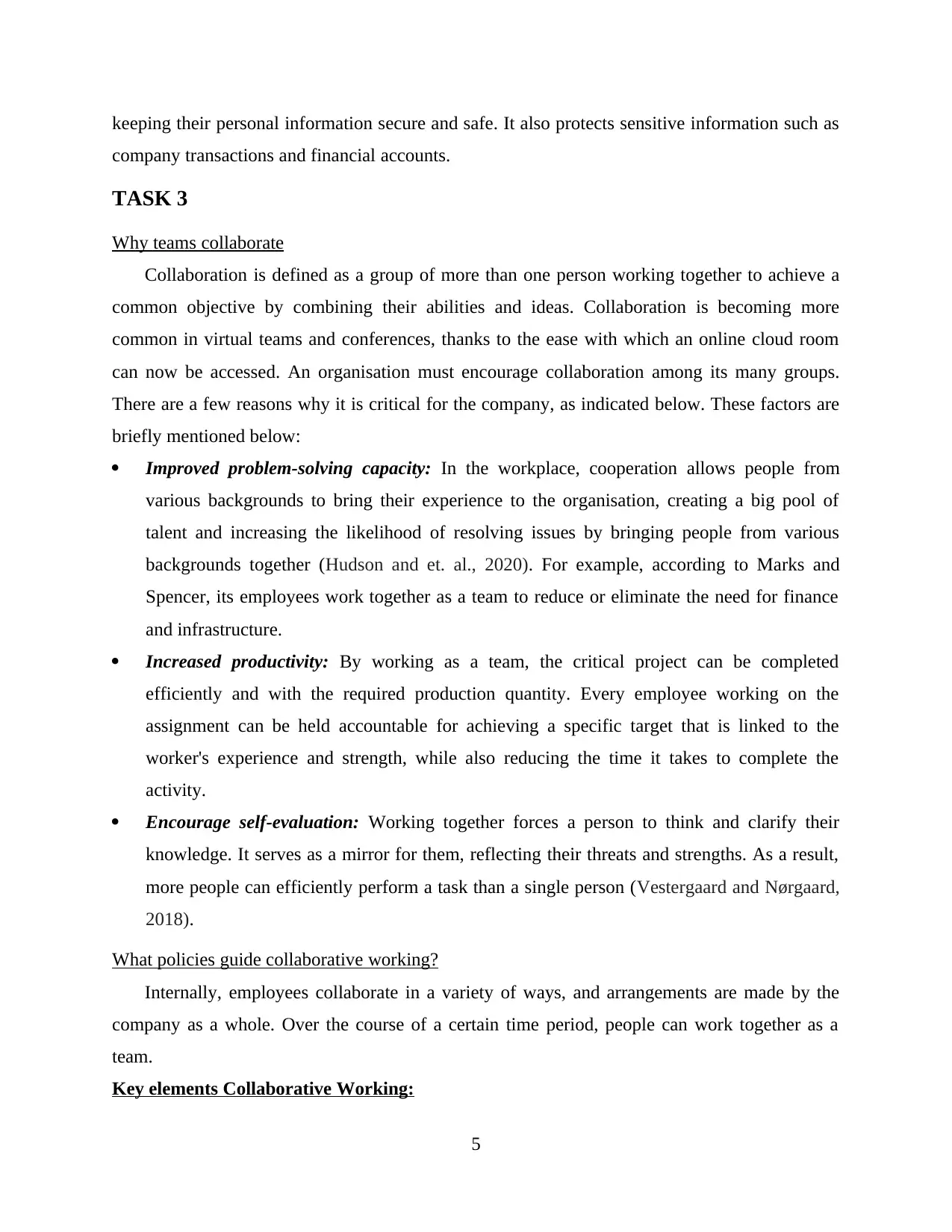
keeping their personal information secure and safe. It also protects sensitive information such as
company transactions and financial accounts.
TASK 3
Why teams collaborate
Collaboration is defined as a group of more than one person working together to achieve a
common objective by combining their abilities and ideas. Collaboration is becoming more
common in virtual teams and conferences, thanks to the ease with which an online cloud room
can now be accessed. An organisation must encourage collaboration among its many groups.
There are a few reasons why it is critical for the company, as indicated below. These factors are
briefly mentioned below:
Improved problem-solving capacity: In the workplace, cooperation allows people from
various backgrounds to bring their experience to the organisation, creating a big pool of
talent and increasing the likelihood of resolving issues by bringing people from various
backgrounds together (Hudson and et. al., 2020). For example, according to Marks and
Spencer, its employees work together as a team to reduce or eliminate the need for finance
and infrastructure.
Increased productivity: By working as a team, the critical project can be completed
efficiently and with the required production quantity. Every employee working on the
assignment can be held accountable for achieving a specific target that is linked to the
worker's experience and strength, while also reducing the time it takes to complete the
activity.
Encourage self-evaluation: Working together forces a person to think and clarify their
knowledge. It serves as a mirror for them, reflecting their threats and strengths. As a result,
more people can efficiently perform a task than a single person (Vestergaard and Nørgaard,
2018).
What policies guide collaborative working?
Internally, employees collaborate in a variety of ways, and arrangements are made by the
company as a whole. Over the course of a certain time period, people can work together as a
team.
Key elements Collaborative Working:
5
company transactions and financial accounts.
TASK 3
Why teams collaborate
Collaboration is defined as a group of more than one person working together to achieve a
common objective by combining their abilities and ideas. Collaboration is becoming more
common in virtual teams and conferences, thanks to the ease with which an online cloud room
can now be accessed. An organisation must encourage collaboration among its many groups.
There are a few reasons why it is critical for the company, as indicated below. These factors are
briefly mentioned below:
Improved problem-solving capacity: In the workplace, cooperation allows people from
various backgrounds to bring their experience to the organisation, creating a big pool of
talent and increasing the likelihood of resolving issues by bringing people from various
backgrounds together (Hudson and et. al., 2020). For example, according to Marks and
Spencer, its employees work together as a team to reduce or eliminate the need for finance
and infrastructure.
Increased productivity: By working as a team, the critical project can be completed
efficiently and with the required production quantity. Every employee working on the
assignment can be held accountable for achieving a specific target that is linked to the
worker's experience and strength, while also reducing the time it takes to complete the
activity.
Encourage self-evaluation: Working together forces a person to think and clarify their
knowledge. It serves as a mirror for them, reflecting their threats and strengths. As a result,
more people can efficiently perform a task than a single person (Vestergaard and Nørgaard,
2018).
What policies guide collaborative working?
Internally, employees collaborate in a variety of ways, and arrangements are made by the
company as a whole. Over the course of a certain time period, people can work together as a
team.
Key elements Collaborative Working:
5
Paraphrase This Document
Need a fresh take? Get an instant paraphrase of this document with our AI Paraphraser
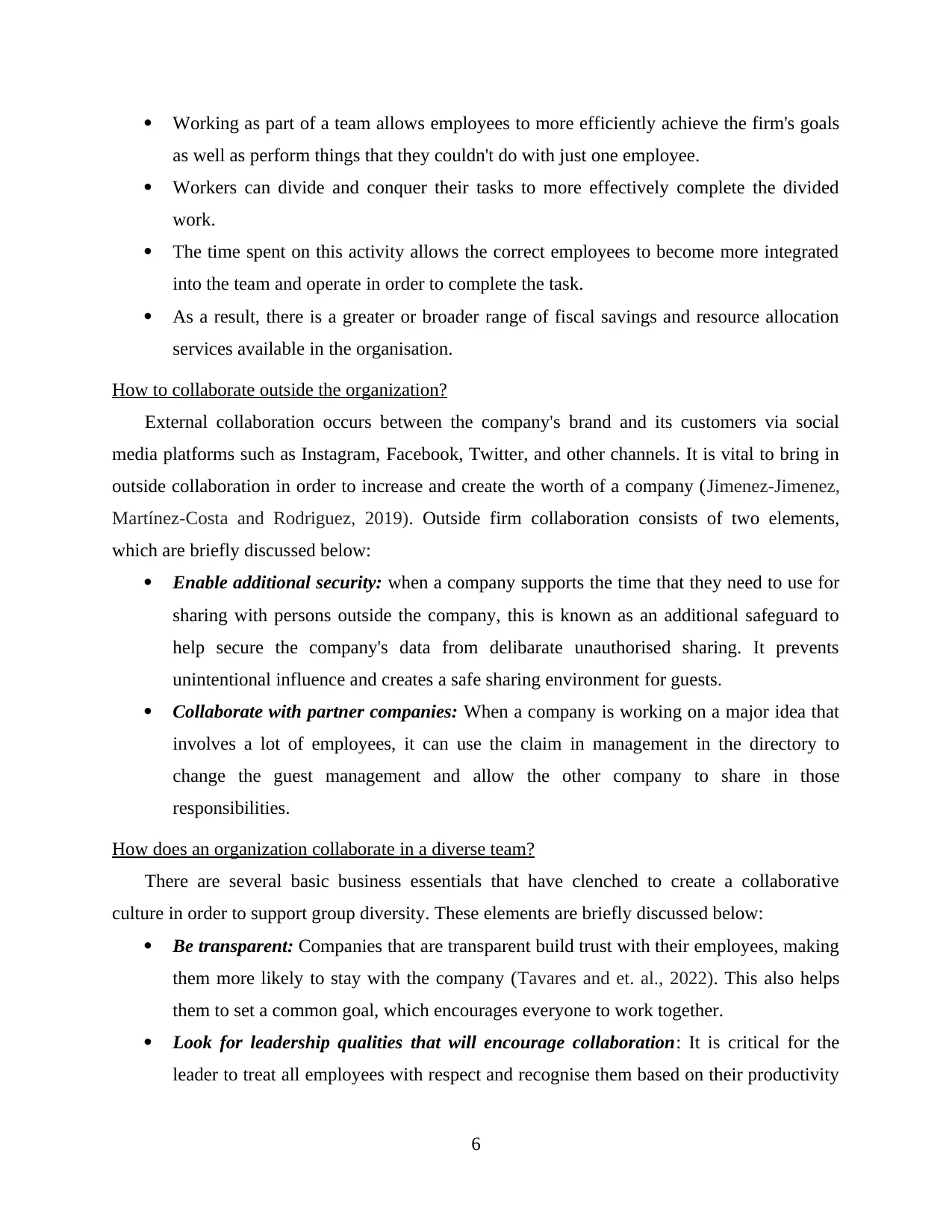
Working as part of a team allows employees to more efficiently achieve the firm's goals
as well as perform things that they couldn't do with just one employee.
Workers can divide and conquer their tasks to more effectively complete the divided
work.
The time spent on this activity allows the correct employees to become more integrated
into the team and operate in order to complete the task.
As a result, there is a greater or broader range of fiscal savings and resource allocation
services available in the organisation.
How to collaborate outside the organization?
External collaboration occurs between the company's brand and its customers via social
media platforms such as Instagram, Facebook, Twitter, and other channels. It is vital to bring in
outside collaboration in order to increase and create the worth of a company (Jimenez-Jimenez,
Martínez-Costa and Rodriguez, 2019). Outside firm collaboration consists of two elements,
which are briefly discussed below:
Enable additional security: when a company supports the time that they need to use for
sharing with persons outside the company, this is known as an additional safeguard to
help secure the company's data from delibarate unauthorised sharing. It prevents
unintentional influence and creates a safe sharing environment for guests.
Collaborate with partner companies: When a company is working on a major idea that
involves a lot of employees, it can use the claim in management in the directory to
change the guest management and allow the other company to share in those
responsibilities.
How does an organization collaborate in a diverse team?
There are several basic business essentials that have clenched to create a collaborative
culture in order to support group diversity. These elements are briefly discussed below:
Be transparent: Companies that are transparent build trust with their employees, making
them more likely to stay with the company (Tavares and et. al., 2022). This also helps
them to set a common goal, which encourages everyone to work together.
Look for leadership qualities that will encourage collaboration: It is critical for the
leader to treat all employees with respect and recognise them based on their productivity
6
as well as perform things that they couldn't do with just one employee.
Workers can divide and conquer their tasks to more effectively complete the divided
work.
The time spent on this activity allows the correct employees to become more integrated
into the team and operate in order to complete the task.
As a result, there is a greater or broader range of fiscal savings and resource allocation
services available in the organisation.
How to collaborate outside the organization?
External collaboration occurs between the company's brand and its customers via social
media platforms such as Instagram, Facebook, Twitter, and other channels. It is vital to bring in
outside collaboration in order to increase and create the worth of a company (Jimenez-Jimenez,
Martínez-Costa and Rodriguez, 2019). Outside firm collaboration consists of two elements,
which are briefly discussed below:
Enable additional security: when a company supports the time that they need to use for
sharing with persons outside the company, this is known as an additional safeguard to
help secure the company's data from delibarate unauthorised sharing. It prevents
unintentional influence and creates a safe sharing environment for guests.
Collaborate with partner companies: When a company is working on a major idea that
involves a lot of employees, it can use the claim in management in the directory to
change the guest management and allow the other company to share in those
responsibilities.
How does an organization collaborate in a diverse team?
There are several basic business essentials that have clenched to create a collaborative
culture in order to support group diversity. These elements are briefly discussed below:
Be transparent: Companies that are transparent build trust with their employees, making
them more likely to stay with the company (Tavares and et. al., 2022). This also helps
them to set a common goal, which encourages everyone to work together.
Look for leadership qualities that will encourage collaboration: It is critical for the
leader to treat all employees with respect and recognise them based on their productivity
6
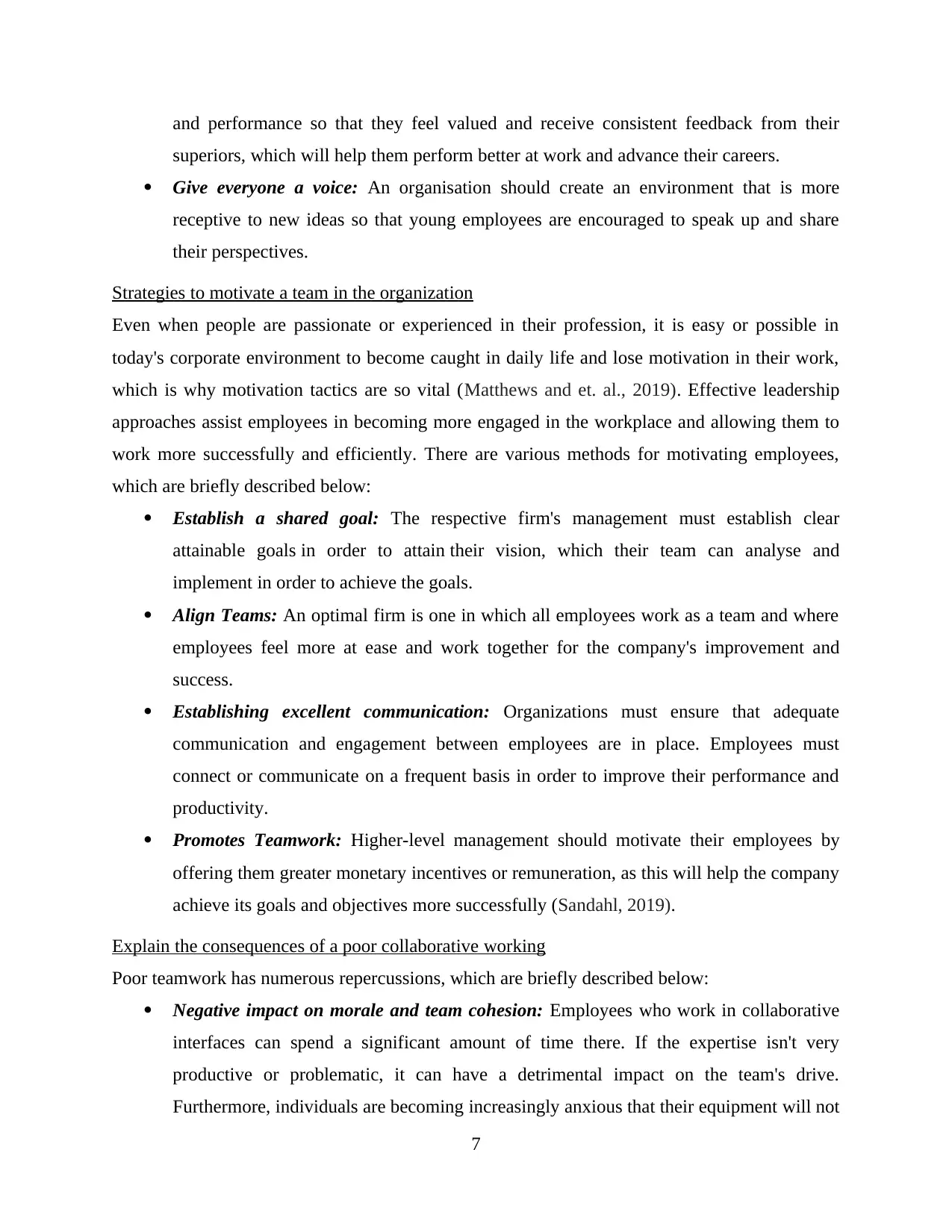
and performance so that they feel valued and receive consistent feedback from their
superiors, which will help them perform better at work and advance their careers.
Give everyone a voice: An organisation should create an environment that is more
receptive to new ideas so that young employees are encouraged to speak up and share
their perspectives.
Strategies to motivate a team in the organization
Even when people are passionate or experienced in their profession, it is easy or possible in
today's corporate environment to become caught in daily life and lose motivation in their work,
which is why motivation tactics are so vital (Matthews and et. al., 2019). Effective leadership
approaches assist employees in becoming more engaged in the workplace and allowing them to
work more successfully and efficiently. There are various methods for motivating employees,
which are briefly described below:
Establish a shared goal: The respective firm's management must establish clear
attainable goals in order to attain their vision, which their team can analyse and
implement in order to achieve the goals.
Align Teams: An optimal firm is one in which all employees work as a team and where
employees feel more at ease and work together for the company's improvement and
success.
Establishing excellent communication: Organizations must ensure that adequate
communication and engagement between employees are in place. Employees must
connect or communicate on a frequent basis in order to improve their performance and
productivity.
Promotes Teamwork: Higher-level management should motivate their employees by
offering them greater monetary incentives or remuneration, as this will help the company
achieve its goals and objectives more successfully (Sandahl, 2019).
Explain the consequences of a poor collaborative working
Poor teamwork has numerous repercussions, which are briefly described below:
Negative impact on morale and team cohesion: Employees who work in collaborative
interfaces can spend a significant amount of time there. If the expertise isn't very
productive or problematic, it can have a detrimental impact on the team's drive.
Furthermore, individuals are becoming increasingly anxious that their equipment will not
7
superiors, which will help them perform better at work and advance their careers.
Give everyone a voice: An organisation should create an environment that is more
receptive to new ideas so that young employees are encouraged to speak up and share
their perspectives.
Strategies to motivate a team in the organization
Even when people are passionate or experienced in their profession, it is easy or possible in
today's corporate environment to become caught in daily life and lose motivation in their work,
which is why motivation tactics are so vital (Matthews and et. al., 2019). Effective leadership
approaches assist employees in becoming more engaged in the workplace and allowing them to
work more successfully and efficiently. There are various methods for motivating employees,
which are briefly described below:
Establish a shared goal: The respective firm's management must establish clear
attainable goals in order to attain their vision, which their team can analyse and
implement in order to achieve the goals.
Align Teams: An optimal firm is one in which all employees work as a team and where
employees feel more at ease and work together for the company's improvement and
success.
Establishing excellent communication: Organizations must ensure that adequate
communication and engagement between employees are in place. Employees must
connect or communicate on a frequent basis in order to improve their performance and
productivity.
Promotes Teamwork: Higher-level management should motivate their employees by
offering them greater monetary incentives or remuneration, as this will help the company
achieve its goals and objectives more successfully (Sandahl, 2019).
Explain the consequences of a poor collaborative working
Poor teamwork has numerous repercussions, which are briefly described below:
Negative impact on morale and team cohesion: Employees who work in collaborative
interfaces can spend a significant amount of time there. If the expertise isn't very
productive or problematic, it can have a detrimental impact on the team's drive.
Furthermore, individuals are becoming increasingly anxious that their equipment will not
7
⊘ This is a preview!⊘
Do you want full access?
Subscribe today to unlock all pages.

Trusted by 1+ million students worldwide
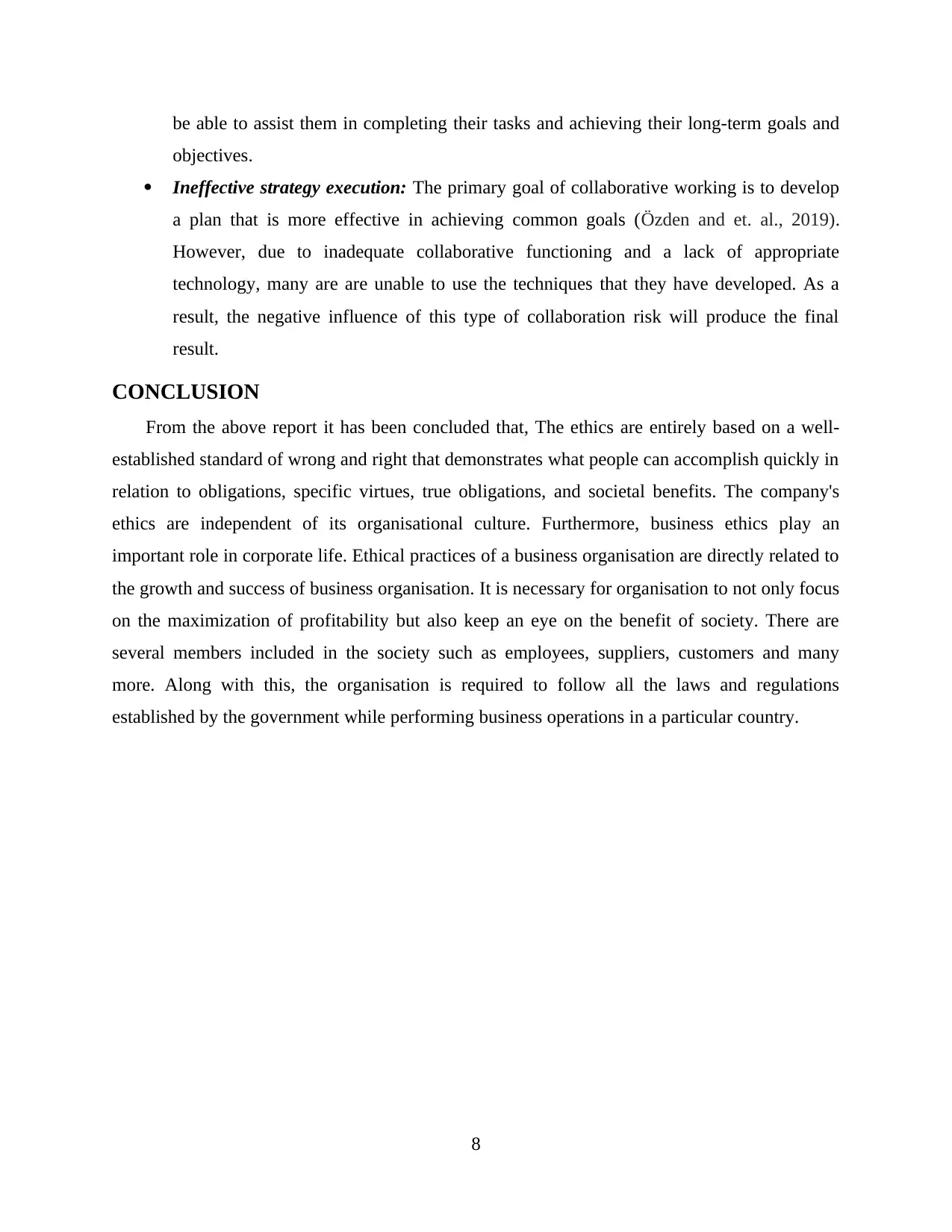
be able to assist them in completing their tasks and achieving their long-term goals and
objectives.
Ineffective strategy execution: The primary goal of collaborative working is to develop
a plan that is more effective in achieving common goals (Özden and et. al., 2019).
However, due to inadequate collaborative functioning and a lack of appropriate
technology, many are are unable to use the techniques that they have developed. As a
result, the negative influence of this type of collaboration risk will produce the final
result.
CONCLUSION
From the above report it has been concluded that, The ethics are entirely based on a well-
established standard of wrong and right that demonstrates what people can accomplish quickly in
relation to obligations, specific virtues, true obligations, and societal benefits. The company's
ethics are independent of its organisational culture. Furthermore, business ethics play an
important role in corporate life. Ethical practices of a business organisation are directly related to
the growth and success of business organisation. It is necessary for organisation to not only focus
on the maximization of profitability but also keep an eye on the benefit of society. There are
several members included in the society such as employees, suppliers, customers and many
more. Along with this, the organisation is required to follow all the laws and regulations
established by the government while performing business operations in a particular country.
8
objectives.
Ineffective strategy execution: The primary goal of collaborative working is to develop
a plan that is more effective in achieving common goals (Özden and et. al., 2019).
However, due to inadequate collaborative functioning and a lack of appropriate
technology, many are are unable to use the techniques that they have developed. As a
result, the negative influence of this type of collaboration risk will produce the final
result.
CONCLUSION
From the above report it has been concluded that, The ethics are entirely based on a well-
established standard of wrong and right that demonstrates what people can accomplish quickly in
relation to obligations, specific virtues, true obligations, and societal benefits. The company's
ethics are independent of its organisational culture. Furthermore, business ethics play an
important role in corporate life. Ethical practices of a business organisation are directly related to
the growth and success of business organisation. It is necessary for organisation to not only focus
on the maximization of profitability but also keep an eye on the benefit of society. There are
several members included in the society such as employees, suppliers, customers and many
more. Along with this, the organisation is required to follow all the laws and regulations
established by the government while performing business operations in a particular country.
8
Paraphrase This Document
Need a fresh take? Get an instant paraphrase of this document with our AI Paraphraser

References:
Books and Journals
Alfter, B., 2019. Cross-border collaborative journalism: A step-by-step guide. Routledge.
Connolly, M., Jacobs, S. and Scott, K., 2018. Clinical leadership, structural empowerment and
psychological empowerment of registered nurses working in an emergency
department. Journal of Nursing Management, 26(7), pp.881-887.
Connolly, M., Jacobs, S. and Scott, K., 2018. Clinical leadership, structural empowerment and
psychological empowerment of registered nurses working in an emergency
department. Journal of Nursing Management, 26(7), pp.881-887.
Friedrich and et. al., 2019. Escaping the professional silo: an escape room implemented in an
interprofessional education curriculum. Journal of interprofessional care, 33(5),
pp.573-575.
Gölgeci and et. al., 2019. A relational view of environmental performance: What role do
environmental collaboration and cross-functional alignment play?. Journal of Business
Research, 96, pp.35-46.
Gutiérrez, L.M. and Gant, L.M., 2018. Community practice in social work: Reflections on its
first century and directions for the future. Social Service Review, 92(4), pp.617-646.
Holbeche, L., 2018. The agile organization: How to build an engaged, innovative and resilient
business. Kogan Page Publishers.
Hudson and et. al., 2020. Rights, interests and expectations: Indigenous perspectives on
unrestricted access to genomic data. Nature Reviews Genetics, 21(6), pp.377-384.
Jimenez-Jimenez, D., Martínez-Costa, M. and Rodriguez, C.S., 2019. The mediating role of
supply chain collaboration on the relationship between information technology and
innovation. Journal of Knowledge Management.
Matthews and et. al., 2019. It is a complicated thing: leaders’ conceptions of students as partners
in the neoliberal university. Studies in Higher Education, 44(12), pp.2196-2207.
Özden and et. al., 2019. The effect of nurses’ ethical leadership and ethical climate perceptions
on job satisfaction. Nursing ethics, 26(4), pp.1211-1225.
Sandahl, J., 2019. The museum definition as the backbone of ICOM. Museum
International, 71(1-2), pp.vi-9.
Tavares and et. al., 2022. Inbreeding and research collaborations in Portuguese higher
education. Higher Education Quarterly, 76(1), pp.102-115.
Vestergaard, E. and Nørgaard, B., 2018. Interprofessional collaboration: An exploration of
possible prerequisites for successful implementation. Journal of Interprofessional
Care, 32(2), pp.185-195.
Wihlborg and et. al., 2018. Facilitating learning through an international virtual collaborative
practice: A case study. Nurse education today, 61, pp.3-8.
9
Books and Journals
Alfter, B., 2019. Cross-border collaborative journalism: A step-by-step guide. Routledge.
Connolly, M., Jacobs, S. and Scott, K., 2018. Clinical leadership, structural empowerment and
psychological empowerment of registered nurses working in an emergency
department. Journal of Nursing Management, 26(7), pp.881-887.
Connolly, M., Jacobs, S. and Scott, K., 2018. Clinical leadership, structural empowerment and
psychological empowerment of registered nurses working in an emergency
department. Journal of Nursing Management, 26(7), pp.881-887.
Friedrich and et. al., 2019. Escaping the professional silo: an escape room implemented in an
interprofessional education curriculum. Journal of interprofessional care, 33(5),
pp.573-575.
Gölgeci and et. al., 2019. A relational view of environmental performance: What role do
environmental collaboration and cross-functional alignment play?. Journal of Business
Research, 96, pp.35-46.
Gutiérrez, L.M. and Gant, L.M., 2018. Community practice in social work: Reflections on its
first century and directions for the future. Social Service Review, 92(4), pp.617-646.
Holbeche, L., 2018. The agile organization: How to build an engaged, innovative and resilient
business. Kogan Page Publishers.
Hudson and et. al., 2020. Rights, interests and expectations: Indigenous perspectives on
unrestricted access to genomic data. Nature Reviews Genetics, 21(6), pp.377-384.
Jimenez-Jimenez, D., Martínez-Costa, M. and Rodriguez, C.S., 2019. The mediating role of
supply chain collaboration on the relationship between information technology and
innovation. Journal of Knowledge Management.
Matthews and et. al., 2019. It is a complicated thing: leaders’ conceptions of students as partners
in the neoliberal university. Studies in Higher Education, 44(12), pp.2196-2207.
Özden and et. al., 2019. The effect of nurses’ ethical leadership and ethical climate perceptions
on job satisfaction. Nursing ethics, 26(4), pp.1211-1225.
Sandahl, J., 2019. The museum definition as the backbone of ICOM. Museum
International, 71(1-2), pp.vi-9.
Tavares and et. al., 2022. Inbreeding and research collaborations in Portuguese higher
education. Higher Education Quarterly, 76(1), pp.102-115.
Vestergaard, E. and Nørgaard, B., 2018. Interprofessional collaboration: An exploration of
possible prerequisites for successful implementation. Journal of Interprofessional
Care, 32(2), pp.185-195.
Wihlborg and et. al., 2018. Facilitating learning through an international virtual collaborative
practice: A case study. Nurse education today, 61, pp.3-8.
9
1 out of 11
Related Documents
Your All-in-One AI-Powered Toolkit for Academic Success.
+13062052269
info@desklib.com
Available 24*7 on WhatsApp / Email
![[object Object]](/_next/static/media/star-bottom.7253800d.svg)
Unlock your academic potential
Copyright © 2020–2025 A2Z Services. All Rights Reserved. Developed and managed by ZUCOL.



